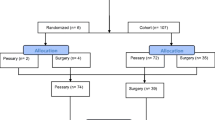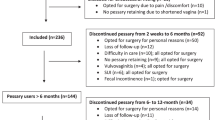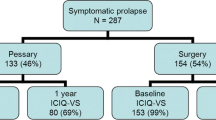Abstract
Introduction and hypothesis
The aim of this study is to establish whether the presence of severe symptoms influences women’s choice of pessaries or surgery for uterovaginal prolapse.
Methods
This is a prospective study using the validated Sheffield Prolapse Symptoms Questionnaire.
Results
Women choosing surgery (n = 251) were younger (58 versus 66 years), more bothered by dragging lower abdominal pain (33% versus 25%, P = 0.04), need for vaginal digitation (8% versus 3%, P = 0.02), and incomplete bowel emptying (27% versus 19%, P = 0.01) than women choosing pessaries (n = 429). More women opting for surgery were sexually active (51% versus 29%, P < 0.0001), perceived avoidance of sex due to prolapse (28% versus 17%, P = 0.000), and perceived prolapse interfering with sexual satisfaction as a severe problem (26% versus 15%, P = 0.000).
Conclusions
Nearly two thirds of women with symptomatic prolapse initially opted for conservative management. Women choosing surgery over pessaries for treatment of prolapse describe more severe symptoms related to bowel emptying, sexual function, and quality of life and are bothered by them.
Similar content being viewed by others
Avoid common mistakes on your manuscript.
Introduction
Pelvic organ prolapse (POP) is associated with older age, vaginal birth, and postmenopausal status and the majority of women with POP are asymptomatic [1]. It is estimated that 11% of all women in the Western world will undergo surgery for prolapse or incontinence in their lifetime and 30% of these will undergo an operation for recurrent prolapse [2]. In 1997, 22.7 out of 10,000 women in the United States underwent surgery for prolapse and, on average, 200,000 women undergo prolapse repair each year [3]. While prolapse can be conservatively managed in women with expectant management or a variety of pessaries, it is the most common indication for hysterectomy in women aged 55 years and older [4]. Reasons for this trend might be the perception among gynecologists that pessaries are suitable only for poor surgical candidates [5] and that nearly half of gynecologists consider sexual activity to be a contraindication to pessary treatment [6].
Recently, there has been interest in factors influencing women’s choice of treatment. Heit et al. [7] first published data on predictors of patient choice in women seeking treatment for POP. They found that pessary treatment was preferred over surgery by women who were older and who had less severe anatomic prolapse. Furthermore, women who had previous surgery for prolapse were more likely to choose surgery again. However, they did not report on preference based on urinary, bowel, or sexual symptoms.
There is increasing emphasis on “symptomatic improvement” as a measure of treatment efficacy in the management of genital prolapse [8]. Studies using patient-centered goals describe symptom relief to be the top priority for women [9], irrespective of whether patients opted for surgery or nonsurgical treatment for prolapse [10-13].
The aim of this study was to establish if women’s choice of either pessaries or surgery is influenced by the presence of severe symptoms associated with prolapse.
Materials and methods
All women, referred to a specialist urogynecology unit in the United Kingdom between June 2002 and July 2007 with bothersome symptomatic POP, were offered both options of conservative and surgical management of prolapse. Following nondirective counseling by the attending physician, the patient made the decision on her first line of management. If the patients required more time to make their decision, a further appointment was made. Women opting for expectant management were referred back to the general practitioner and their details were not added to the database. Commonly used pessary types included the ring, cube, donut, and gellhorn. All women completed the validated Sheffield Prolapse Symptoms Questionnaire [14] in the waiting area prior to being seen by a physician. The Sheffield Questionnaire elicits responses to 26 prolapse-related symptoms (general, urinary, bowel, sexual, quality of life). It also addresses the issue of bothersomeness of each symptom complex. Responses are graded on a four-point Likert scale where applicable (never, occasionally, most of the time, all of the time). A symptom was judged to be “severe” if the patient complained of it being present “most” or “all the time” and it was described as “quite a problem” or “a serious problem” on the bother scale. The questionnaire forms part of our routine clinical evaluation of patients with prolapse. All patients gave written consent to use the data from questionnaires for scientific publications, and this was sanctioned by the local research and development committee. Prolapse was graded by the Baden–Walker halfway system.
Data was analyzed using the SPSS version15.0 (SPSS, Chicago, IL, USA). Fisher’s exact two-tailed tests were used to compare the two groups, P values <0.05 were regarded as significant.
Results
Six hundred eighty women who attended the urogynecology unit with bothersome prolapse and chose either surgery or pessary treatment completed the Sheffield Prolapse Symptoms Questionnaire. Two hundred fifty-one women chose to have surgery (median 58 years, SD 13) while 429 women opted for pessary reduction of prolapse (median 66 years, SD 13). Thus, nearly two thirds of referred women chose to have a pessary for initial management of prolapse. Details of previous surgery, grade of prolapse, and leading edge of prolapse are shown in Table 1. Grade 2 POP was found in more than half of the women in the surgery and pessary groups, and cystocele was the leading edge of the prolapse in both groups.
The predominant symptoms (of any severity) affecting women who attended our clinic with symptomatic prolapse were presence of a vaginal lump (89%, 606 out of 680), urinary urgency (82%, 557 out of 680), urge incontinence (74%, 501 out of 679), dragging pain in the lower abdomen (68%, 461 out of 678), difficulty in bladder emptying (67%, 457 out of 680), difficulty in evacuating bowels (62%,421 out of 674), and fecal urgency (53%,360 out of 680).
On the bother scale, vaginal lump (86%, 575 out of 672), urinary urgency (74%, 499 out of 671), urge incontinence (67%, 450 out of 668), dragging pain in the lower abdomen (64%, 430 out of 673), voiding difficulty (61%, 406 out of 671), and difficulty evacuating bowels (54%, 357 out of 665) were perceived as being a problem.
The frequency of severe general prolapse, urinary and bowel symptoms, sexual function, and quality of life issues are shown in Table 2. Women who opted for surgery were more likely to report severe symptoms of incomplete bowel emptying and need for vaginal digitation to complete defecation. Women who opted for surgery were more likely to be bothered by dragging pain in the lower abdomen, need for vaginal digitation, and incomplete bowel emptying. Significantly more women who opted for surgery would be unhappy if they had to live with their prolapse without any treatment.
The most significant differences were in the domain of sexual function. More women who opted for surgery were sexually active and perceived avoidance of sex due to the prolapse as a severe problem. Women who opted for surgery were also more likely to perceive prolapse interfering with sexual satisfaction as a problem.
Discussion
In this study, we found that women who opted for surgery were more likely to report severe symptoms of vaginal digitations and incomplete emptying of bowels and be bothered by them. In addition, they also felt that prolapse significantly affected their enjoyment of life and that they would be “unhappy/very unhappy” if they had to endure their condition without any treatment. On extensive search of the literature, we have not been able to find another study looking at the role of symptom severity, sexual function, and general quality of life issues in patient decision making of management options. Heit et al. [7] included patients who had previously tried pessary treatment and also women who had “expectant” management but did not report on urinary, bowel, or sexual symptoms.
Prolapse has previously been shown to have a negative impact on sexual function [15]. In the present study, more women in the group that opted for surgical treatment of prolapse were sexually active than the group that chose pessaries. Twenty-eight percent of them tended to avoid sexual activity compared to 17% in the pessary group. Compared to the pessary group, significantly more women in the surgery group perceived diminished sexual satisfaction due to prolapse as a problem (26% versus 15%). A possible explanation for these differences could be that women who opted for surgery were younger (median 58 years) than women who chose pessaries (median 66 years) although the standard deviations of age in the two groups overlapped. It is also possible that some women in the surgery group were not aware that a pessary could help in this situation. Indeed, Brincat et al. [16] reported that women who were sexually active were more likely to continue pessary use, suggesting that long-term pessary use is acceptable to sexually active women. We have previously shown sexual function to improve after pessary reduction of prolapse [17]. Similarly, surgery for prolapse has been shown to improve sexual function in some studies [18-22], although others have cited no change or worsening due to dyspareunia [23, 24]. This suggests that sexual function can improve with both surgical and nonsurgical management of prolapse.
A limitation of this study is that we did not correlate the anatomical compartment of the prolapse with symptom severity. However, one of the questions asked in our study was whether the “vaginal lump came out altogether,” and a similar number of women in the surgery and pessary groups described this as a severe symptom (61% versus 67%, P = 0.13), and both groups were similar with respect to grades of prolapse distribution and leading edge of prolapse (Table 1). Moreover, previous investigators have found no correlation between symptoms and compartment of prolapse [25] or the grade of prolapse [26]. Although the pessary group was older in the present study, they did not describe more symptoms. Similarly, Weber et al. found that, while increasing severity of prolapse was associated with interference with sexual activity, it did not affect the degree of sexual satisfaction or the frequency of intercourse [27]. Another limitation is the lack of longitudinal follow-up data, although our group has previously published medium-term results of women managed with pessaries [17].
While the literature suggests that pessary treatment is effective in reducing prolapse-associated symptoms [17] and is acceptable to sexually active women [16], physicians maybe biased in their assessment of a woman’s suitability for pessary treatment [6]. Patients themselves may have preconceived notions, and their beliefs and attitudes regarding the etiology and perceived “success” of each treatment choice may influence health-seeking behaviors such as treatment choice.
Our findings suggest that women who choose surgery over pessaries for treatment of prolapse describe more severe and bothersome symptoms relating to bowel emptying, sexual function, and quality of life.
References
Swift SE (2000) The distribution of pelvic organ support in a population of female subjects seen for routine gynecologic health care. Am J Obstet Gynecol 183:277–285
Olsen AL, Smith VJ, Bergstrom JO, Colling JC, Clark AL (1997) Epidemiology of surgically managed pelvic organ prolapse and urinary incontinence. Obstet Gynecol 89:501–506
Subak LL, Waetjen LE, van den Eeden S, Thom DH, Vittinghoff E, Brown JS (2001) Cost of pelvic organ prolapse surgery in the United States. Obstet Gynecol 98:646
Wilcox LS, Koonin LM, Pokras R, Strauss LT, Xia Z, Peterson HB (1994) Hysterectomy in the United States, 1988–1990. Obstet Gynecol 83:549–555
Pott-Grinstein E, Newcomer JR (2001) Gynecologist’s patterns of prescribing pessaries. J Reprod Med 46:205–208
Cundiff GW, Weidner AC, Visco AG, Bump RC, Addison WA (2000) A survey of pessary use by members of the American urogynecologic society. Obstet Gynecol 95:931–935
Heit M, Rosenquist C, Culligan P, Graham C, Murphy M, Shott SS (2003) Predicting treatment choice for patients with pelvic organ prolapse. Obstet Gynecol 101:1279–1284
Weber AM (2001) Anterior colporrhaphy: a randomised trial of three surgical techniques. Am J Obstet Gynecol 185:1299–1306
Hullfish KL, Bovbjerg VE, Gibson J, Steers WD (2002) Patient-centred goals for pelvic floor dysfunction surgery: what is success and is it achieved? Am J Obstet Gynecol 187:88–92
Lowenstein L, Fitzgerald MP, Kenton K, Dooley Y, Templehof M, Mueller ER, Brubaker L (2008) Patient-selected goals: the fourth dimension in assessment of pelvic floor disorders. Int Urogynecol J Pelvic Floor Dysfunct 19:81–84
Elkadry EA, Kenton KS, Fitzgerald MP, Shott S, Brubaker L (2003) Patient-selected goals: a new perspective on surgical outcome. Am J Obstet Gynecol 189:1551–1557
Clemons JL, Aguilar VC, Tillinghast TA, Jackson ND, Myers DL (2004) Risk factors associated with an unsuccessful pessary fitting trial in women with pelvic organ prolapse. Am J Obstet Gynecol 190:345–350
Hullfish KL, Bovbjerg VE, Steers WD (2004) Patient-centred goals for pelvic floor dysfunction surgery: long-term follow-up. Am J Obstet Gynecol 191:201–205
Bradshaw HD, Hiller L, Farkas AG, Radley S, Radley SC (2006) Development and psychometric testing of a symptom index for pelvic organ prolapse. J Obstet Gynaecol 26:241–252
Novi JM, Jeronis S, Morgan MA, Arya LA (2005) Sexual function in women with pelvic organ prolapse compared to women without pelvic organ prolapse. J Urol 173:1669–1672
Brincat C, Kenton K, Fitzgerald MP, Brubaker L (2004) Sexual activity predicts continued pessary use. Am J Obstet Gynecol 191:198–200
Fernando RJ, Thakar R, Sultan AH, Shah SM, Jones PW (2006) Effect of vaginal pessaries on symptoms associated with pelvic organ prolapse. Obstet Gynecol 108:93–99
Handa VL, Zyczynski HM, Brubaker L et al (2007) Sexual function before and after sacrocolpopexy for pelvic organ prolapse. Am J Obstet Gynecol 197:629.e1–629.e6
Komesu YM, Rogers RG, Kammerer-Doak DN, Barber MD, Olsen AL (2007) Posterior repair and sexual function. Am J Obstet Gynecol 197:101.e1–101.e6
Paraiso MF, Barber MD, Muir TW, Walters MD (2006) Rectocele repair: a randomized trial of three surgical techniques including graft augmentation. Am J Obstet Gynecol 195:1762–1771
Barber MD, Visco AG, Wyman JF, Fantl JA, Bump RC, Continence Program for Women Research Group (2002) Sexual function in women with urinary incontinence and pelvic organ prolapse. Obstet Gynecol 99:281–289
Weber AM, Walters MD, Piedmonte MR (2000) Sexual function and vaginal anatomy in women before and after surgery for pelvic organ prolapse and urinary incontinence. Am J Obstet Gynecol 182:1610–1615
Pauls RN, Silva WA, Rooney CM et al (2007) Sexual function after vaginal surgery for pelvic organ prolapse and urinary incontinence. Am J Obstet Gynecol 197:622.e1–622.e7
Kahn MA, Stanton SL (1997) Posterior colporrhaphy: it’s effect on bowel and sexual function. Br J Obstet Gynaecol 104:82–86
Ellerkmann RM, Cundiff GW, Melick CF, Nihira MA, Leffler K, Bent AE (2001) Correlation of symptoms with location and severity of pelvic organ prolapse. Am J Obstet Gynecol 185:1332–1338
Fialkow MF, Gardella C, Melville J, Lentz GM, Fenner DE (2002) Posterior vaginal wall defects and their relation to measurements of pelvic floor neuromuscular dysfunction and posterior compartment symptoms. Am J Obstet Gynecol 187:1443–1448
Weber AM, Walters MD, Schover LR (1995) Sexual function in women with uterovaginal prolapse and urinary incontinence. Obstet Gynecol 85:483–487
Conflicts of interest
None.
Author information
Authors and Affiliations
Corresponding author
Rights and permissions
About this article
Cite this article
Kapoor, D.S., Thakar, R., Sultan, A.H. et al. Conservative versus surgical management of prolapse: what dictates patient choice?. Int Urogynecol J 20, 1157–1161 (2009). https://doi.org/10.1007/s00192-009-0930-x
Received:
Accepted:
Published:
Issue Date:
DOI: https://doi.org/10.1007/s00192-009-0930-x




